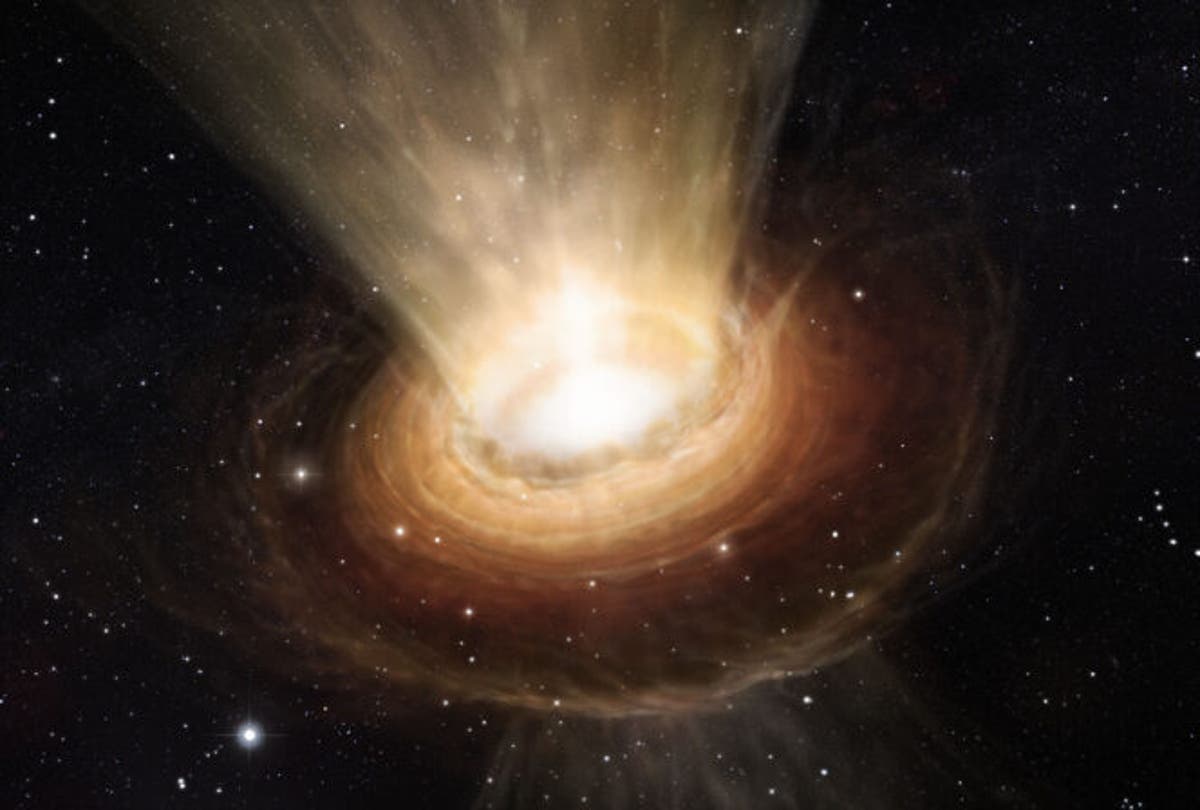It takes a long time for a supermassive black hole to grow, even when it’s eating voraciously. So how supermassive black holes, billions of times the mass of the Sun, formed in the first billion years of the universe has been an enigma.
But new work by an international team of cosmologists suggests an answer: streams of cold matter sculpted by mysterious dark matter, force-feeding black holes born from the deaths of giant primordial stars.
“There is a recipe for creating a 100,000 solar mass black hole at birth, and that is a 100,000 solar mass primordial star,” said Daniel Whalen, a cosmologist at the University of Portsmouth The Independent. “In today’s Universe, the only black holes we have detected are all formed by the collapse of massive stars. So that means the minimum mass for a black hole will probably have to be at least three to four times the mass of the Sun.”
But the gap is huge between a 4-solar-mass star and a 100,000-solar-mass star, a “supergiant” star that, if centered on the Sun, would extend to Pluto’s orbit. In the last 20 years, according to Dr. Whalen, much of the research on quasars in the early Universe — very bright centers of galaxies powered by supermassive black holes — has focused on the finely tuned conditions that would allow such a massive primordial star to form.
But in a new article published in the magazine Natureuse dr Whalen and his colleagues used supercomputer models of cosmic evolution to show that rather than evolving from a set of very peculiar circumstances, hypergiant primordial stars form quite naturally from a set of initial conditions and decay into the “seeds” of quasars, though still relatively rare, are far less sensitive. And it all starts with dark matter.
“If you look at the total content, we call it the total mass-energy content of the universe, 3 percent of which is in the form of matter that we understand,” said Dr. Whalen – Matter made up of protons, neutrons and electrons, hydrogen, helium and so on. But “24 percent is in the form of dark matter, and we know it’s there because of the movement of galaxies and galaxy clusters, but we don’t know what it is.”
That is, dark matter appears to interact with normal matter only through gravity, and dark matter’s gravity created the largest structure in the universe: the cosmic web. Early in the universe, huge expanses of dark matter collapsed under their own weight into long filaments, said Dr. Whalen, and dragged normal matter with them, forming a web of filaments and their intersections
Galaxies and stars would eventually form within the filaments and particularly the matter-rich intersections of the filaments.
“We call them halos, cosmological halos,” said Dr. Whalen about the intersections, “and we think that’s where primordial stars formed first.”
Previous considerations suggested that a halo would need to grow to massive proportions under special conditions in order to form a primordial star large enough to give birth to a supermassive black hole and create a quasar within the first billion years of the universe: none other stars too close, molecular hydrogen formation to keep the gas cool, and supersonic gas flows keeping the halo turbulent. As long as the halo is cool and turbulent enough, it cannot coalesce enough to ignite as a star, prolonging its growth phase until it is eventually born at an enormous size.
And once a massive star ignites, lives its life, burns out, and collapses into a black hole, it needs access to large amounts of gas to become supermassive, said Dr. Whalen, “because the way the black hole grows is by gas swallowing”.
But rather than requiring finely tuned conditions for the formation of a massive star and eventual massive black hole, Dr. Whalen and his colleagues suggest that cold gas flowing out of the dark matter-defined filaments of the cosmic web into a halo could replace the set of factors necessary for primordial star formation in older models.
“If cold accretion currents drive the growth of these halos, they must crush these halos,” said Dr. Whalen, “pounding them so fast with so much gas that turbulence could prevent the gas from collapsing and forming a primordial star. ”
Simulating one such halo fed by cold accretion currents, the researchers saw two massive primordial stars form, one as massive as 31,000 suns and the other as massive as 40,000 suns. The seeds of supermassive black holes.
“It was wonderfully easy. The problem disappeared overnight for 20 years,” said Dr. choose Any time you have cold currents pumping gas into a halo in the cosmic web, “you’re going to have so much turbulence that you get supermassive star formation and massive seeding that creates a massive quasar seed.”
It’s a finding consistent with the number of quasars observed so far in the early Universe, he added, noting that large halos are rare in this early epoch, as are quasars.
But the new work is a simulation, and scientists next want to actually observe the formation of a quasar in the early Universe in the wild. New instruments like the James Webb Space Telescope could make this a reality relatively soon.
“Webb will be able to see one,” said Dr. Whalen and perhaps considered the birth of black holes within a million years or so of the Big Bang.

